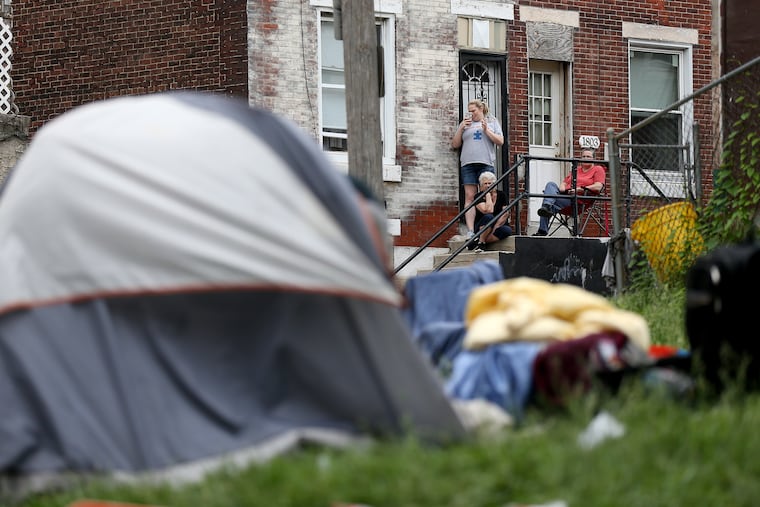‘You wouldn’t hold an AA meeting in a bar’: Kensington neighbors don’t want a supervised injection site | Solomon Jones
Just days after the Philadelphia primary election, Kensington is in the throes of the opioid crisis.

As I walked toward Kensington Avenue to meet with several community members, I passed a dozen or more people brazenly shooting heroin on nearby Shelbourne Street, and a man smoking crack at a bus stop as a group of women watched him warily.
This is a normal day for Kensington in the throes of an opioid crisis, just days after Philadelphia’s primary election. Mayor Jim Kenney, who will likely earn a second term, based on his primary win in this largely Democratic city, says he wants one or more supervised injection sites to deal with the more than 1,100 overdoses that took place in Philadelphia last year. A nonprofit called Safehouse has proposed placing such a site in this community, and the push for that site has begun in earnest, now that Kenney has all but won re-election.
But Kensington’s neighborhood leaders, along with many longtime residents and business owners, adamantly oppose placing such a site in their community, and they’ve sworn to fight it until the bitter end. They say they feel ignored — disrespected even — as people who don’t live in their neighborhood try to decide the community’s fate.
Shannon Farrell, president of the Harrowgate Civic Association, met me on Kensington Avenue and walked me to Hilton Street.
“These are the houses that don’t exist,” she said wryly, pointing to row homes at the end of the 1800 block of Hilton Street.
It was a reference to the contention by supervised injection site proponents that 1851 E. Hilton Street, where Safehouse could reportedly open its first supervised injection site, is a non-residential area.
This neighborhood has borne the brunt of the opioid crisis, with addicted people periodically living in tents under bridges and shooting up boldly in public. Farrell said she believes the city allowed it to get that bad so that officials could bolster their argument for an injection site. Kenney and others have argued that Philadelphia must take a different approach from what was done during the crack epidemic of the 1990s, when the drug crisis led to mass arrests.
As Farrell pointed to the needles on the ground, we stopped next to a gate maybe 50 feet from the back of a daycare center where a group of people leaned against the rear wall. One of them had a needle in his leg. Others had needles in their arms.
“We have more shootings in our neighborhood. We never had shootings," she said. "We never had children shot in our neighborhood. Now we’ve had them killed and shot. Kids were able to just come out on Ontario Street and walk right down the street to go to Webster [Elementary School]. Now they have to zigzag through the neighborhood to avoid drug dealers to get to school where they feel safe.”
As Farrell spoke, three police officers on bicycles rode by, just a few feet from where the group was openly shooting drugs. Farrell said she was told the police have been instructed not to make arrests.
Contacted to clarify the policy, police spokesperson Tanya Little said: “We enforce the law. The law is you can’t use open-air drugs. However, it’s a sad situation. Our goal is to get them help and to stop the ones who are selling the drugs, which is the bigger problem.”
Standing there on Hilton Street, however, I didn’t see the police stopping anyone.
As we crossed the street, dodging piles of human excrement near the Hispanic Community Counseling Services, a group of workers came outside and looked disapprovingly at those shooting drugs.
“Look at these people over here,” said Rosa Santiago, one of the employees. “They’re over here having a blast. They go between our cars, they break in our cars, they slash our tires. I don’t think that should be right. We trying to make money, so we can live right and we have all this going on and people just want to make it worse for us. It shouldn’t be like that.”
Asked whether the supervised injection site should be on Hilton Street, Santiago said: “No, it shouldn’t be. It’s too many of them. And even if it was on this block, I don’t think they would use it, because they have too much pride. They would rather be in the street than go in the building and do their injections.
I asked what she thought could be done to solve the problem.
“Get help,” Santiago said. “Help them get help, help them clean up, and help them get out of here and let them know, hey, y’all don’t want to get any help, but we’re going to clean up, so you don’t belong in this block.”
Farrell put it more succinctly.
“You wouldn’t hold an AA meeting in a bar,” she said, referring to the fact that recovery centers in Kensington are often challenged by drug dealers who wait to sell to people exiting the facilities.
I believe Farrell is right.
Solomon Jones is the author of 10 books. Listen to him weekdays 7 to 10 a.m. on 900 AM/ 96.1 FM WURD. Email him at sj@solomonjones.com. On Twitter at @solomonjones1